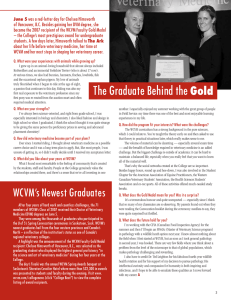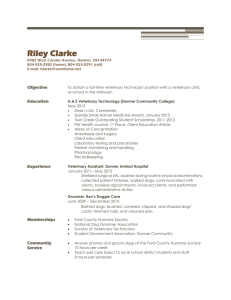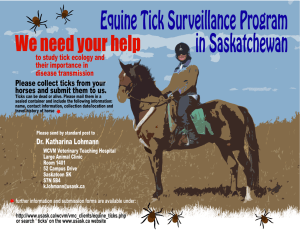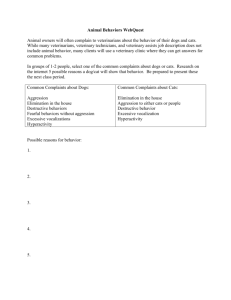S CAHF funds pet health research teams at U of S
advertisement
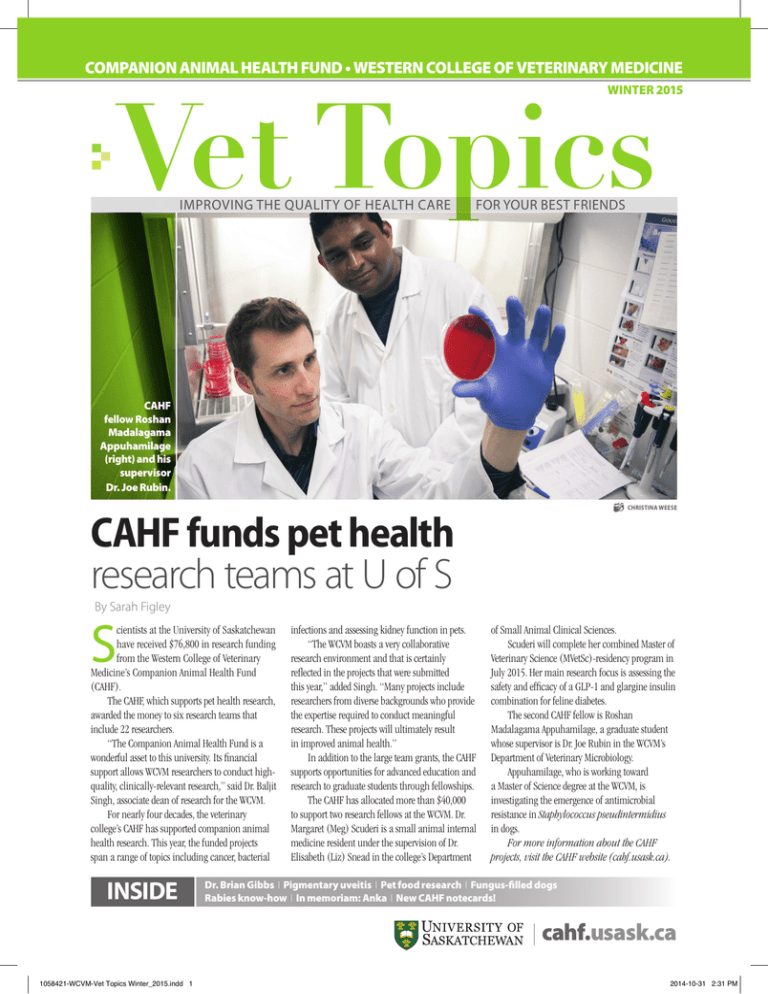
COMPANION ANIMAL HEALTH FUND • WESTERN COLLEGE OF VETERINARY MEDICINE WINTER 2015 improving the quality of health care for your best friends CAHF fellow Roshan Madalagama Appuhamilage (right) and his supervisor Dr. Joe Rubin. CAHF funds pet health research teams at U of S Christina Weese By Sarah Figley S cientists at the University of Saskatchewan have received $76,800 in research funding from the Western College of Veterinary Medicine’s Companion Animal Health Fund (CAHF). The CAHF, which supports pet health research, awarded the money to six research teams that include 22 researchers. “The Companion Animal Health Fund is a wonderful asset to this university. Its financial support allows WCVM researchers to conduct highquality, clinically-relevant research,” said Dr. Baljit Singh, associate dean of research for the WCVM. For nearly four decades, the veterinary college’s CAHF has supported companion animal health research. This year, the funded projects span a range of topics including cancer, bacterial INSIDE infections and assessing kidney function in pets. “The WCVM boasts a very collaborative research environment and that is certainly reflected in the projects that were submitted this year,” added Singh. “Many projects include researchers from diverse backgrounds who provide the expertise required to conduct meaningful research. These projects will ultimately result in improved animal health.” In addition to the large team grants, the CAHF supports opportunities for advanced education and research to graduate students through fellowships. The CAHF has allocated more than $40,000 to support two research fellows at the WCVM. Dr. Margaret (Meg) Scuderi is a small animal internal medicine resident under the supervision of Dr. Elisabeth (Liz) Snead in the college’s Department of Small Animal Clinical Sciences. Scuderi will complete her combined Master of Veterinary Science (MVetSc)-residency program in July 2015. Her main research focus is assessing the safety and efficacy of a GLP-1 and glargine insulin combination for feline diabetes. The second CAHF fellow is Roshan Madalagama Appuhamilage, a graduate student whose supervisor is Dr. Joe Rubin in the WCVM’s Department of Veterinary Microbiology. Appuhamilage, who is working toward a Master of Science degree at the WCVM, is investigating the emergence of antimicrobial resistance in Staphylococcus pseudintermidius in dogs. For more information about the CAHF projects, visit the CAHF website (cahf.usask.ca). Dr. Brian Gibbs I Pigmentary uveitis I Pet food research I Fungus-filled dogs Rabies know-how I In memoriam: Anka I New CAHF notecards! cahf.usask.ca 1058421-WCVM-Vet Topics Winter_2015.indd 1 2014-10-31 2:31 PM 2014-15 CAHF Research Projects • Metformin: a new potential cancer drug for dogs? Drs. M. Casey Gaunt, Charlotte Johnson, Valerie MacDonald Dickinson and Trisha Dowling, WCVM; and Dr. Ryan Dickinson, Prairie Diagnostic Services. • Investigating the connection between E.coli infections and cancer. Drs. Valerie MacDonald, Charlotte Johnson and Joseph Rubin, WCVM. • Examining the details of a common bacterium found in dogs. Drs. Joseph Rubin and M. Casey Gaunt, and Roshan Madalagama Appuhamilage, WCVM. • Evaluating chest tube fluids may provide better animal care. Drs. Sherisse Sakals, Germaine Hung, Casey Gaunt, Joseph Rubin and Greg Starrak, WCVM. • A new method for detecting kidney disease in cats. Drs. Elisabeth Snead, James Montgomery and Jewel Milo, WCVM; Drs. Carl Wesolowski and Michal Wesolowski, U of S College of Medicine. • SAMe (S-adenosylmethionine) may have antioxidant potential in companion animals. Drs. Katharine Woods and Astrid Kjaergaard, WCVM. Vet Topics is published by the Western College of Veterinary Medicine’s Companion Animal Health Fund. Visit www.cahf.usask.ca for more information. Managing editor: Myrna MacDonald For article reprints, contact pethealth@usask.ca Comments? Contact: Myrna MacDonald (myrna.macdonald@usask.ca) Vet Topics, WCVM, U of S, 52 Campus Drive, Saskatoon, SK S7N 5B4 To report a change of address or to request a withdrawal from the mailing list, contact: pethealth@usask.ca By Lynne Gunville CAHF Supporters Dr. Brian Gibbs (WCVM ’70) Dr. Brian Gibbs’ decision to become a veterinarian was greatly influenced by one person: his grandmother. “She was probably the last person in Saskatoon to raise chickens and sell eggs,” says Gibbs. “And when I was a kid, I used to catch the city bus over to her place on Friday nights and spend the weekend helping her. I’d look after her dogs and cats, feed the chickens, pick and clean the eggs – I just really liked doing that.” Gibbs was always most interested in working with small animals, and after graduating from the Western College of Veterinary Medicine (WCVM) in 1970, he went on to work at Whitebirch Animal Hospital (now Westward Animal Hospital) in his home town of Saskatoon. In 1975, he purchased the Central Animal Hospital. Although his clinic was one of just a few small animal clinics operating at that time, Gibbs says that, over the years, he has witnessed a major shift in people’s attitudes toward their pets. “Pets are no longer considered chattels today. They’ve moved from the yard to the house to the bed in a generation. I think it’s an evolution through society, and it’s difficult to come up with a single explanation. But whatever the reason, pets have become more important to people today than they were in the past.” Pets have always been important to Gibbs who can recall very few times in his life when he didn’t have his own dog. He now has four pets – a cat and three dogs – that live on the family acreage. His dogs, an Alaskan malamute and two standard poodles, were all adopted as adults from people who couldn’t keep them for various reasons. For Gibbs, work has always been a source of great satisfaction: “I’ve always enjoyed making a diagnosis that was elusive – it’s the thrill you get when you find the answer. I also like the idea of making something better that wasn’t well, and I guess that goes along with the idea of making clients happy because we’ve made their pet well.” Over the years, Gibbs has been a staunch supporter of the WCVM as well as the Companion Animal Health Fund (CAHF). He’s gratified that the fund has been so well used over the years in its support of studies that have brought about huge gains in small animal medicine. “But like all charities, they have difficulty getting funding, and there are so many other organizations out there competing for the money. That’s why we’ve decided that our clinic’s charitable donations will always be related to animal health and welfare,” explains Gibbs. “We identify with the pets – that’s why I went into veterinary medicine. It’s all about working with the pets.” V 2 • Vet Topics • Winter 2015 1058421-WCVM-Vet Topics Winter_2015.indd 2 2014-10-31 2:31 PM With inconsistent information, the golden retriever community is unsure of how to move forward. “[There are] always more questions than answers when it comes to PU,” says Linda Verges, who breeds golden retrievers in Calgary, Alta. My project this summer was to help provide some answers to some of the most commonly-asked questions. What proportion of western Canadian golden retrievers have PU? Are there early markers of the disease? What is the mode of inheritance: is it dominant or recessive? The answers to these questions lay hidden in the vast pools of data stored in the Veterinary Medical Centre’s medical records. I spent two months compiling ophthalmology records, By Vanessa Holly recording each appointment from every golden retriever seen at the WCVM in the past 10 years. Having a decade’s worth of information is an invaluable resource that allows us to follow the progression of the disease. Past appointments of PU-affected dogs can be checked for any early indications of disease before the diagnosis was confirmed. Access to a long-term database also gives us the ability to detect PU in multiple generations — data that’s essential for finding a mode of inheritance. In the absence of a genetic test, knowing the mode of inheritance can provide breeders with some guidance about decisions that will improve the health of their breeding lines. Determining a mode of inheritance requires tracing individual dogs back to large family lines and looking for parents, siblings or offspring that have been diagnosed with the eye disease. To date, we have identified over 60 dogs that have been diagnosed with PU or detected early markers of the disease from a family of 393 golden retriever dogs. Fortunately, compiling data on more than 800 golden retriever dogs has allowed us to achieve all of the goals of our study, the results of which should be published in the near future. So back to my first question: why would I spend my summer working with paper instead of puppies and kittens? Because this project matters to everyone. I’ve spoken with owners devastated by the loss of eyesight in their best friends. I’ve met heartbroken breeders who have abandoned whole breeding lines. I’ve listened to frustrated veterinarians who can find neither a cause nor a cure. The sad reality is that this is a painful, expensive disease for many dogs — and it’s growing in numbers. To all of the veterinary students who are looking for summer jobs, I urge you to keep an open mind and consider doing research. While clinical experience is important, there are many things to be learned from working in a research environment. I’ve found more purpose with my project this summer than I ever anticipated, thanks to breeders such as Linda Verges and to the college’s team of veterinary ophthalmologists. For me, this summer was a wonderful, “eye-opening” experience. V Pigmentary uveitis remains a mystery M y eyes burn and it feels like I haven’t blinked for days. I’ve been sitting for hours, sifting through case files in the records office of the Western College of Veterinary Medicine’s (WCVM) Veterinary Medical Centre. I let out a sigh that erupts a plume of dust: I’ve hardly even made a dent in the mountain of paper before me. So why would I spend my entire summer drowning in a sea of hospital records? Is this really worth it? That’s when I remember the words of WCVM ophthalmologist Dr. Bruce Grahn: “Pigmentary uveitis is one of the most challenging inherited diseases we’ve dealt with in any breed of dog.” Grahn kick-started this retrospective study of pigmentary uveitis (PU) after years of watching golden retrievers go blind from the disease and being unable to provide pet owners with any definite answers. Also known as golden retriever uveitis or pigmentary and cystic glaucoma, PU is a painful, inherited eye disease in golden retrievers that often progresses to blindness. Unfortunately, predicting which dogs will become diseased and when they will show clinical signs is nearly impossible — a fact that frustrates breeders and owners alike. Many golden retrievers are bred before they ever show signs of the disease, which means that the genetics responsible for PU can be unknowingly passed on to future generations. “[PU] has an extremely variable onset. We don’t even know the mode of inheritance. I don’t think there’s a clean line in North America,” says Grahn, who is supervising my research along with WCVM ophthalmologists Drs. Lynne Sandmeyer and Bianca Bauer. Despite growing concern about the disease, only four peer-reviewed research papers that focus on the disease have been published. The shortage of scientific literature targeting PU has led to a lot of confusion among practitioners. “Veterinarians probably aren’t even aware of the disease, and veterinary ophthalmologists aren’t consistent in what they are telling people,” says Grahn. Vanessa Holly (above) of Sherwood Park, Alta., is a third-year veterinary student who participated in the WCVM’s Undergraduate Summer Research and Leadership program in 2014. Western College of Veterinary Medicine • 3 1058421-WCVM-Vet Topics Winter_2015.indd 3 2014-10-31 2:31 PM Do pulses belong in pet food? A three-year study at the University of Saskatchewan (U of S) may find a new use for some of the province’s most popular pulse crops – peas, faba beans and lentils. The study plans to look at the digestibility and glycemic index of different pulse starches for cats and dogs. Researchers are hoping to demonstrate that by replacing corn (a common pet food ingredient) with pulses, they can achieve lower blood sugar levels in cats and dogs. “Our overall goal is to find diets that provide a low glycemic index and all the health benefits that come with it,” says Western College of Veterinary Medicine (WCVM) research associate Kyla Zatti. She and graduate student Jennifer Briens are working with Dr. Lynn Weber, an associate professor n the college’s Department of Veterinary Biomedical Sciences. The project team also includes Drs. Murray Drew and Tom Scott from the U of S College of Agriculture and Bioresources. “When an animal (or human) eats starch, some of that starch is metabolized as sugar in the bloodstream,” Zatti explains. “This rise in blood sugar levels is measured by the glycemic index (GI). In humans, diets that provide a low GI are linked to a lower incidence of obesity, diabetes and heart disease, among other health benefits.” The wide-ranging study will compare the effect of four different starches (peas, faba beans, lentils and corn) in omnivores and carnivores across three different species – cats, dogs and two varieties of fish. Corn is included as a control starch. One of the study’s goals is to develop GI indexes for these starches in cats and dogs. That will help to determine which pulse starch can provide the highest digestibility and the lowest GI. “Omnivores (dogs) and carnivores (cats) digest and use carbohydrates differently. Carnivores in nature eat a strict protein diet. The problem with pet food is that it’s very high in carbohydrates, which carnivores have a hard time digesting. We’re looking for the best mix of carbs and protein,” says Zatti. If researchers can provide pets with a more compatible diet, health effects from diseases such as diabetes, obesity and heart disease may be mitigated. “This is especially true for carnivores such as cats,” says Zatti. “Cats don’t have as high an activity of the enzymes that break down carbohydrates, so they’re more vulnerable to high blood sugars (and resulting insulin spikes) which contribute to Type II diabetes.” “We know it’s true for humans,” Briens adds. “When you compare pulses to rice and corn — two common pet food ingredients — pulses are definitely providing a lower glycemic index. But there’s little actual research done on GI on cats.” The study will also include two fish species: Nile tilapia (omnivores) and rainbow trout (carnivores). The WCVM researchers hope to be able to make recommendations on the use of pulses in commercial fish food for aquaculture operations. The study starts with the eight cats that have already arrived at the university. The research team will eventually repeat the study in a group of beagles. In the first part of the study, researchers will feed a whole-food diet containing one of the test starches for a total of eight weeks. They’ll then By Christina Weese test feces collected from the animals and fish to see how much undigested starch More health news travels through the species’ digestive tract. at www.cahf.usask.ca “For the digestibility trial, we acclimate them for a week on the diet,” explains Zatti. An indigestible “marker” is included in the feed at a ratio of 30 per cent starch to one per cent marker. Researchers will weigh and measure the ratio of starch to marker in the feces to determine how much of the starch was digested. In the second part of the study, the animals will be fed small amounts of pure starch in both extruded and non-extruded forms. “Extruding changes the digestibility of the starch, much like cooking changes the digestibility of food—so we want to test both kinds of pure starches,” says Briens. For this part of the study, the cats will only participate one or two days per week. Researchers will feed each cat a small amount of a specific starch and then perform a few simple tests such as a blood pressure test and a cardiac ultrasound examination. Researchers will also take a number of blood samples over several hours to determine a GI curve index for corn and for the pulses. “The cats have to sit for these tests without any sedatives,” says Zatti, “so we have to make sure the research room is a happy place with lots of treats and play time.” Zatti and Briens also take pains to ensure the cats are happy and well socialized. The animals are kept in group housing and are in constant contact with people and with each other. After the three-year study is complete, they’ll be adopted out to homes in the community through a selective adoption process. Any animals that are withdrawn from the study for handling reasons or health concerns are adopted out right away. Collected data will help to flesh out other parts of this wide-ranging study. For example, blood samples will be studied for biomarkers of inflammation, oxidative damage and stress. Another graduate student, Marina Subramaniam, is also using the project’s results to study a genetic component of nutrition. With funding from the Natural Sciences and Engineering Research Council of Canada (NSERC), Saskatchewan Pulse Growers, Alliance Grain Trades and Horizon Pet Foods, this study is a great example of collaboration between U of S researchers and partners in industry. V 4 • Vet Topics • Winter 2015 1058421-WCVM-Vet Topics Winter_2015.indd 4 2014-10-31 2:32 PM CAHF fellow helps fungusfilled dogs P hysicians use the drug voriconazole in their human patients to cure fungal infections in difficult-to-treat sites and to combat fungal diseases such as systemic aspergillosis. But can this anti-fungal drug be used in dogs? While the use of voriconazole in dogs hasn’t been extensively studied, the drug does offer advantages over other medications. “This drug has a very good penetration in most tissues includBy Melissa Cavanagh ing brain tissue, and it has a wide spectrum of activity against most clinically important yeasts and moulds,” says Dr. Julie Lemetayer, who completed her residency in small animal medicine this summer at the Lemetayer only grew interested in small animal medicine during her Western College of Veterinary Medicine (WCVM). senior years of veterinary school while completing externships in Canada, “Voriconazole can be more efficient than other commonly used antiEngland and Scandinavia. fungal drugs in diseases such as aspergillosis, candidiasis and cryptococ“I did an externship in Sweden in a zoo and a student there was cosis.” doing a research project [that involved] watching antelopes, so I followed Aspergillosis mainly develops in immunocompromised people and is him,” says Lemetayer. “I actually found it a bit boring – I was more caused by a fungus that’s found indoors and outdoors. interested in what the veterinarian was doing. Other researchers have tested the drug for use in dogs and measured “I also found that with wildlife and exotics, you really need to like its concentration in the blood of canine subjects after treatment, but to do surgery because that’s such a big part of it,” she says, adding that Lemetayer and her supervisor, Dr. Sue Taylor, had further questions. surgery isn’t her favourite part of clinical veterinary medicine. “We wanted to know what would be the concentration of the drug in One of her mentors advised Lemetayer that an internship in small all body fluids after the dog receives treatment – in cerebral spinal fluids, animals would be helpful for a career as an exotic veterinarian. She ended in the eye, in the joints and in the lungs,” says Lemetayer, who was the up thoroughly enjoying the medical aspects of small animal medicine 2013-14 Companion Animal Health Fund (CAHF) research fellow. during her internship in a small animal referral centre in France. As a In the WCVM study, the researcher gave the drug to six sled dogs and result, she decided to continue in small animal internal medicine and then anesthetized the animals so that all samples could be taken from came to the WCVM for a residency. them in the most stress-free way possible. Lemetayer tested drug conLemetayer thinks she’ll continue working with her newfound passion centrations in the dogs’ blood, cerebral spinal fluid, joints and aqueous for small animal medicine. humour – the liquid inside the eyeball. “[Small animal medicine] is really advanced . . . you can do so “The study that was done before was on beagles. They’re the most much and it’s so interesting.” V common dogs used for research, but they have a particular metabolism,” Above: Dr. Julie Lemetayer. Photo: Melissa Cavanagh. Melissa is says Lemetayer, who wanted to use dogs that would better represent the a third-year veterinary student and was the WCVM’s research average pet. The sled dogs participating in the WCVM study were a mixcommunications intern for the summer of 2013. ture of breeds ranging from huskies and malamutes to border collies and German shepherd crosses. Lemetayer completed the sampling portion of her project in 2012. After sampling was complete, local people adopted the six dogs. The new dog owners include Lemetayer who now owns a mixed-breed sled dog named Chinook. • Dr. Meg Scuderi, resident, small animal internal medicine. A veterinary career hasn’t always been LemeResearch focus: feline diabetes tayer’s goal: “I actually wanted to be a behaviourist Supervisor: Dr. Liz Snead before – I was more interested in wildlife.” But based on the advice of a senior veterinary • Roshan Madalagama Appuhamilage, graduate student, student, Lemetayer enrolled in veterinary medimicrobiology cine versus biological studies at Nantes’ National Research focus: antimicrobial resistance in dogs Veterinary College in France where she completed her Supervisor: Dr. Joe Rubin veterinary degree in 2009. 2014-15 CAHF RESEARCH FELLOWS Western College of Veterinary Medicine • 5 1058421-WCVM-Vet Topics Winter_2015.indd 5 2014-10-31 2:32 PM The best prevention is to vaccinate all cats, dogs and ferrets against rabies, regardless of whether they’re indoor or outdoor pets. By Melissa Cavanagh Rabies: what you need to know M ost pet owners aren’t concerned about their animals contracting rabies, but the reality is that infection with the deadly virus usually results in death for animals as well as people. “There’s no cure for rabies disease,” says Dr. Jordan Woodsworth, wellness veterinarian at the Western College of Veterinary Medicine’s Veterinary Medical Centre. Rabies is transmitted through salivary secretions of infected animals. Bites are the most common source of transmission, but infection can also occur through salivary contact with mucous membranes such as the mouth and eyes. “What happens is that the rabies virus is introduced into the body through the bite wound, and then it travels by peripheral nerves to the central nervous system (CNS). The closer the bite is to the CNS, the faster the disease will progress,” explains Woodsworth, adding that the incubation period can last anywhere from three weeks to six months. If given early post-exposure treatment, some animals will mount an effective enough immune response to fight the infection. But once the virus reaches the central nervous system, Woodsworth says nothing can be done. If a veterinarian suspects rabies, the affected animal is humanely euthanized before the virus More health news at: progresses any further. The rabies virus causes muscle paralysis, and eventually, an infected animal will not be able to move its lungs to breathe. Rabies can’t be definitively diagnosed until a post mortem examination of brain tissue is performed. The best prevention is to vaccinate all cats, dogs and ferrets against rabies, regardless of whether they’re indoor or outdoor pets. People such as veterinarians and other health care practitioners who are at risk for coming in contact with potentially rabid animals should also be vaccinated. Dogs and cats as young as three months old can be given the rabies vaccine, and a booster shot is required one year later. Depending on the specific vaccine used, additional booster shots are required every one to three years. Rabies is a zoonotic disease — a disease that can be passed from animals to other animals and humans. And since infection almost always results in death, the health risk for humans is enormous. “Anytime an unvaccinated animal comes to us with clinical signs such as unexplained neurologic symptoms, seizures, blindness, behaviour changes or hypersalivation, rabies is on the list of differential diagnoses,” says Woodsworth. If a rabid animal bites an unvaccinated pet, the unvaccinated animal could be A placed in quarantine for up to six months as a safety precaution. In Saskatchewan, the recommendation to quarantine an affected animal is made by a veterinary inspector. Authorized personnel in similar roles make the decision to quarantine in other Canadian provinces. But even if your pet is vaccinated, call your veterinarian if it’s bitten by a wild animal. Your veterinarian may still recommend quarantining your pet, and it should undergo a recommended post-exposure protocol. If you suspect your pet or another animal to have rabies, proceed with extreme caution. Wear gloves and put the animal into a crate where they can’t bite anyone. Uncharacteristic behaviours may be seen in rabid animals so even previously gentle pets may bite if they become infected. The safest mode of action is to contact your local animal control office if you suspect an animals to be rabid or call the Saskatchewan rabies information line at 1-844-7-RABIES (1-844-772-2437). If a person has been bit or has been in contact with an animal that may be rabid, please contact your local public health authorities. For more information about rabies and its prevention, visit the rabies information page on the U.S. Centers for Disease Control and Prevention (CDC) web site — www.cdc.gov/rabies. V www.cahf.usask.ca 6 • Vet Topics • Winter 2015 1058421-WCVM-Vet Topics Winter_2015.indd 6 2014-10-31 2:32 PM We have established Anka’s Best Friend Fund in her memory so she may continue to help others afflicted with TCC. Anka never lost her smile O n February 3, 2012, our beautiful Norwegian elkhound Anka succumbed to complications from bladder cancer (transitional cell carcinoma or TCC) a few weeks shy of her fifteenth birthday. Anka bravely fought her cancer for over two years. She never lost her smile through the operations, tests and treatments. And she never lost her unique ability to make every adult and child she met feel special. Anka — or “Ankee” — loved people, especially children. She believed that her mission in life was to bring a little bit of happiness into the lives of everyone she happened to meet during the day. She accomplished this by staring and smiling at any passersby until they finally returned her smile. If they had the good sense to come over and pet her, then Anka would doubly reward them with a vigorous tail wag. Over the years we never ceased to be amazed by Anka’s powers to cheer up the biggest grumps. She could pick them out in a crowd hundreds of feet away, and somehow, she could compel them to turn toward her and make eye contact. We always watched in amazement as these people were slowly lifted out of their worrisome thoughts and tuned into Anka’s stare. Their look of surprise would give way to a smile, sometimes only for a brief moment as they continued to walk by. But more often than not, they would break into laughter. Ankee knew then that she had helped to brighten that person’s day and that they would remember their encounter. We never realized until after Anka’s passing how special she had made us feel in public. Every day we see so many sad people going about their lives, and we feel sad that Ankee is not with us to bring a momentary ray of sunshine into their lives. One never knows how a brief smile from Anka may have changed a person’s day or perhaps his entire life. Anka remained strong and vibrant for two years after her initial diagnosis with TCC. She never lost her love for life or for food. Many were the nights when she would sit atop “her” 100-acre farm and howl for hours with the distant coyotes across the valleys. Anka’s initial tumour was removed surgically. Rather than start chemotherapy, we opted for an immune modulation, Cordyceps (fungus)based product called “K9 Immunity.” Along with transfer factor, fish oil and a careful diet, there was no indication that the TCC ever metastasized over the subsequent two years. But a year after the first surgery, the tumour reappeared in the same location and was removed surgically. Anka was then placed on piroxicam (non-steroidal anti-inflammatory drug), but that medication was stopped after six months due to weakening of her renal function. A few months later, the tumour reappeared in the same location but could not be surgically removed due to her kidney issues. When her urethra became blocked, we drove Anka to New courtesy of Anka’s family Jersey’s Ridgewood Veterinary Hospital where Dr. Dean Cerf successfully cleared the urethra using ultrasound guided endoscopic laser ablation. We were most hopeful for Anka, but the anesthesia proved too much for her compromised kidneys. We did get her home and now she sleeps peacefully on the farm she loved so much. We have established Anka’s Best Friend Fund in her memory so she may continue to help others afflicted with TCC. Through the support of research efforts into its prevention, early detection and treatment, we hope that Anka will continue to touch the hearts of all who come to know her through this fund. Ankee taught us the real meaning of life. She found wonder and joy in the little things right in her own backyard. She taught us to slow down, live in each moment and appreciate everything around us. No need to travel to far off exotic places – just take a walk with “The Ank”! Anka was and continues to be our life-support system. She was a true “Dog of Valour.” Thank you Ankee for being our best friend and for taking such good care of us. We miss you so much. Love, Anka’s Mom and Dad V For more information about Anka’s Best Friend Fund, contact the WCVM Development Office (wcvm.supportus@usask.ca or 306-966-7450). Read Anka’s full story at cahf.usask.ca Western College of Veterinary Medicine • 7 1058421-WCVM-Vet Topics Winter_2015.indd 7 2014-10-31 2:32 PM “Little blue eyes.” Christina Weese INTRODUCING OUR NEW CAHF Pet Notecards Just in time for Christmas! Only $20 for 16 cards! This holiday season, take a fresh approach to giftgiving and pick up some sets of our beautiful pet notecards for your family, friends and clients. Produced by the Companion Animal Health Fund (CAHF), each set of 16 blank cards features four images of adorable pets* in brilliant colour. Our notecard sets are perfect for all of those pet lovers on your list. Plus your purchase will help to support vital pet health research and education programs at the Western College of Veterinary Medicine (WCVM). TO ORDER: • Call 306-966-7268 • Email wcvm.supportus@usask.ca • Visit www.cahf.usask.ca to download an order form and submit your order by mail. cahf.usask.ca LIMITED TIME ONLY! Buy 2012 CAHF dog notecard sets for $10! * Cat and dog sets are sold separately. Check out Vet Topics online at www.cahf.usask.ca PUBLICATIONS MAIL AGREEMENT NO. 40112792 RETURN UNDELIVERABLE CANADIAN ADDRESSES TO: Research Office, WCVM University of Saskatchewan 52 Campus Drive Saskatoon SK S7N 5B4 wcvm.research@usask.ca Want more pet health news in your mailbox? Go to www.cahf.usask.ca and sign up to receive the Vet Topics e-newsletter online! Printing Services • 306-966-6639 • University of Saskatchewan 1058421-WCVM-Vet Topics Winter_2015.indd 8 2014-10-31 2:32 PM


